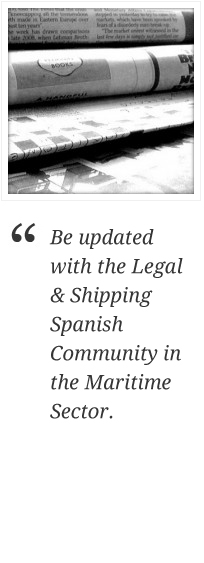February: CIRCULAR 1A/2011
The New Port State Control Regime (NIR), adopted in Spain by Royal Decree 1737/2010, in force since 01/01/11.
The New Inspection Regime (NIR) introduced by Paris MoU, was elaborated by the European Union, EMSA[1] and member Authorities of the Paris MoU, following all the requirements of the new EU Directive on Port State Control, together with the national laws of each Paris MoU Member States. Its main objective is the need to harmonize inspection procedures and also the criteria to control ships.
The NIR has been recently adopted in Spain by Royal Decree 1737/2010, enforced as from January 1st 2011, being applicable to foreign ships entering Spanish Ports. The aim of the Royal Decree is to achieve higher maritime safety and protection, as well as protection of the environment, and the health and safety of the people aboard ships.
Inspections will still remain to be initial, detailed and expanded, the main change being the frequency between inspections which will depend on the risk profile of each ship, which replaces the previous Target Factor. The risk profile is determined by a combination of generic and historic parameters. The Ship Risk Profile is classified in: Low Risk Ships (LRS), Standard Risk Ships (SRS) and High Risk Ships (HRS). A ship will be considered to have a low, standard or high risk, depending on several criteria, like:
- Type of ship: tankers, bulk, oil, gas and chemical ships are considered of higher risk.
- Age of ship: ships over twelve (12) years old are considered of higher risk.
- Performance of the State Flag of the ship: ships with a State Flag with a high level of detentions in the European Union and Paris MoU region are considered of higher risk.
- Performance of the recognized organizations: ships with certificates issued by recognized organizations with low or very low levels of detentions in the European and Paris MoU Zones are considered of low risk
- Performance of the company responsible for the ISM management, number of deficiencies and number of detentions: ships belonging to companies with a bad history regarding levels of deficiencies and detentions in the European and Paris MoU area are considered of higher risk.
- Number of detentions: ships that have been detained more than once are considered of higher risk.
When determining risk profiles, the relative parameters regarding the type of ship, flag performance history and organizations and companies performances, will be given more importance.
Regarding application criteria in Spain, according to Article 3 of the Royal Decree, it will be applied to all ships calling or operating in Spanish Ports, except fishing ships, war ships, auxiliary ships, primitive wood made ships, state ships with no commercial ends and recreation ships with no commercial ends.
The Ministry of Development will choose the ships to be inspected according to their risk profile. The gap between periodic inspections for high risk ships will not exceed six months and this gap between periodic inspections to ships with other risk profile will increase as the risk profile decreases.
All ships that have not been yet inspected in a European Union or Paris MoU region will be inspected by the Spanish Marine General Direction Authorities according to their risk profile:
- High Risk Profile ships, if not inspected within the last six months, have to be inspected when calling to a Spanish Port.
- Standard Risk Profile ships have to be inspected every 12 months,
- Low Risk Profile ships have to be inspected every three years.
But regardless of the periodic inspection, additional inspections will be carried out on ships with priority factors like:
- suspended or retired class for safety reasons since last inspection in European area,
- with a report or notification by other State,
- not identified or that cannot be identified by the inspection data base,
- collided prior to entering a Port,
- ships accused of not following rules regarding the dumping of hazardous materials, and
- ships with erratic or unsafe driving.
SHIP DETENTION WITHIN A SANCTIONING PROCEDURE FOLLOWING PSC INSPECTION
It is important to note that the NIR is independent from the Spanish Sanctioning Administrative Procedure that can be followed against the ship and Ship Owners, if any deficiency found during the NIR can be considered as an infringement to the Spanish Ports Law 27/2003. As mentioned in our previous Circulars, within the Sanctioning Procedures, the vessel can be detained as a cautionary measure to secure the imposition of fines, being only able to lift such detention by granting the guarantee requested.
Concerning the Administrative Sanctioning Procedure and the fines imposed, a lot has been written and said in the shipping circle recently and not any evidence have necessarily been put on the table. What can be noted is that there are some deficiencies found in the Paris MoU inspections that usually can lead to a detention of the ship within the Administrative Sanctioning Procedure such as:
- ISM deficiencies,
- Irregularities in Crew Certificates,
- General lack of maintenance on board and in accommodations (dirtiness, irregularities in food and catering, etc),
- Sludge’s tanks illegal connections and / or any deficiency related to maritime pollution prevention,
- Inoperative Fire Safety Measures, Radio and Safety Equipments
- Lack of required ship`s certifications,
- Lack of maintenance in the Engine Room (oil leaks),
- Structural deficiencies (corrosion),
As mentioned in our previous CIRCULAR, if a Ship Owner considers that the detention of the ship and amount of guarantee requested in the Administrative Sanctioning Procedure is excessive or groundless, it is paramount to provide as much evidence as possible (independent survey reports, certificates, photographs, etc) at an early stage of the procedure, as it is a legal procedure that can be appealed before Madrid Superior Administrative Courts and, if necessary, before the Spanish Supreme Court.
[1]Â Â Â Â Â Â Â Â Â Â European Maritime Safety Agency

